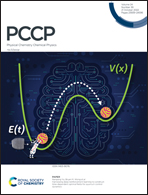Transmission of spin-polarization by π-orbitals: an approach to assessing its effect on NMR spin–spin coupling and EPR hyperfine structure†‡
Abstract
A new approach to assessing the effect of the transmission of spin-polarization by π-orbitals (π-TSP) is presented. In order to switch off the π-TSP effect, we artificially average the α- and β-densities of the valence π-orbitals when calculating the exchange–correlation contribution to the Fock matrix in the unrestricted Kohn–Sham framework. The π-TSP effect is then evaluated as the difference between the results obtained with switched-on and switched-off options. This approach is applied to estimate the π-TSP effect on the Fermi-contact contribution to spin–spin couplings and EPR hyperfine structure coupling constants. The π-TSP effect on the distribution of spin-density, spin–spin coupling pathways and pathways of EPR hyperfine couplings is demonstrated for benzene, naphthalene, 1,3,5,7,9-decapentaene and the 1,3,5,7,9-decapentaen-1-yl radical. The sign alternation of the spin-polarization transmitted by π-orbitals is explained in a theoretical framework based on perturbation theory. However, the delocalized nature of the π-system can interfere with the sign alternation in certain cases, two of which – the cyclobutadiene dication and the cyclooctatetraene dication – are examined, and an explanation for which is provided.

- This article is part of the themed collection: 2022 PCCP HOT Articles


 Please wait while we load your content...
Please wait while we load your content...